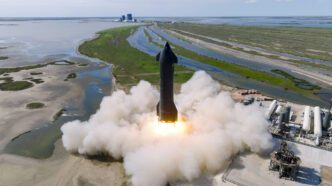SpaceX marked both progress and setbacks on Tuesday with its latest Starship test flight, the ninth in the company’s ongoing quest to build a fully reusable spacecraft. Starship successfully separated from its Super Heavy booster and reached orbit for the first time this year—but the mission ended with an uncontrolled descent into the Indian Ocean.
After liftoff from SpaceX’s Boca Chica facility in southern Texas, the mission began smoothly. It was the most stable Starship test of 2025 so far, following two back-to-back explosive failures. Notably, this flight used a flight-proven Super Heavy booster for the first time—a key milestone as SpaceX pushes for reusable launch systems.
The booster completed a clean separation, and Starship made it to space. But problems started soon after.
One goal of this test was to open a side hatch to simulate satellite deployment. That system failed. Later in the mission, Starship lost attitude control, meaning it couldn’t orient itself correctly for re-entry. As a result, the spacecraft began to spin and eventually re-entered Earth’s atmosphere in an uncontrolled descent, splashing down in the Indian Ocean. SpaceX had cleared airspace in the area ahead of the event.
Steady Progress Despite Setbacks
This latest attempt comes just days after the Federal Aviation Administration gave SpaceX the green light to resume flights. The FAA had grounded the Starship program earlier this year after two mid-air anomalies, one in January and another in March.
In the January test, Starship made it into orbit after separating from its booster, but suffered a failure mid-flight. Debris fell into the skies near Puerto Rico, leading the FAA to reroute several aircraft in response.
By March, SpaceX had managed to recover the booster for a third time using its Texas launch tower—an impressive technical feat. But that flight saw Starship lose multiple Raptor engines just eight minutes into its journey, sending it into a spin.
After those failures, the FAA required SpaceX to expand hazard zones for future launches. SpaceX also implemented key hardware upgrades designed to improve reliability and safety. While Tuesday’s mission didn’t go entirely as planned, the successful orbit and clean booster recovery reflect significant progress.
The company continues refining its system with an eye toward future deep-space missions. As the Starship program inches closer to operational status, each test—win or fail—brings it closer to that goal.













